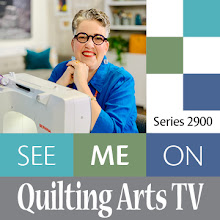
I’ve been online friends with Sarah Ann Smith for several years, but just met her at Quilt Market and Festival this fall, and guess what? She has a great new book just out, too! To celebrate, we are both giving away copies of our books. Leave a comment here on my blog after this post, and you can enter to win her book or her Nourish pattern (see photo below). Go to Sarah’s blog, where she is reviewing my book, Appliqué Petal Party, leave a comment after her post, and you can enter to win my book or my Pinata Purse pattern. Double the fun!
I’ll draw a winner at random from those who post by noon on Monday, Dec. 16.
Here is a photo of Sarah’s beautiful quilt, Nourish the Body, Nourish the Soul :

Threadwork Unraveled (AQS, 2009, 111 pages, $28.95) is both an excellent reference book on how to use thread to enhance pieced and appliqued quilts, and an inspiring look at how some of today’s best quilt artists are using thread in their work. Best of all, Sarah’s sparkling personality and sense of humor shine through on every page. (Kudos to the AQS editor who was smart enough not to edit out Sarah’s unique voice.)
Threadwork Unraveled provides an amazing amount of information about:
- thread – weights and plies, strength, how it is made, different types of thread and their advantages and disadvantages, and how to select the right type of thread for your project.
- needles – sizes, structure, types, when to change needles, selecting needles for different kinds of threads, and troubleshooting tips.
- sewing machine basics – throat plate, feet, harp, lighting, speed control, tension, thread path, using a thread stand. Note: This section would be particularly informative for those trying to determine which features they want when purchasing a new machine.
- workspace and ergonomics issues – the sewing surface, chairs, and proper body positioning.
- foundations – stabilizers (tear-away, heat-away, wash-away, cut-away/leave in; freezer paper; coffee filters and dryer sheets; machine tape; copy paper/tracing paper), hoops and batting.
- marking tools – pencils, chalk, pens, scoring tools, transfer paper, how to mark a quilt and how to remove markings.
- applique – using thread to outline machine applique, and as a design element on its own; using thread to tone down, shade and highlight; stitching options (straight stitch, blind hem, blanket stitch, zigzag stitch, satin stitch, decorative stitches); and using thread to add visual texture, contrast and value.
- machine quilting – quilt top, backing, batting, basting, alternatives to pin basting, starting and stopping, stitch length, speed, getting sharp points, practice tips, stitching density, blocking, quilting designs.
In my mind, Sarah’s information on tension (both in the top thread path and in the bobbin) and how to solve tension issues is well worth the entire price of the book. When I teach machine free-motion quilting, at least half of my students’ problems are tension related. Sarah explains these issues in a straight-forward, step-by-step way that will be useful to quilters of all experience levels.
The section of the book that inspired me most was the machine quilting section. Using lots of examples from her own work and that of other exceptional art quilters, Sarah ponders many issues quilters face when trying to decide on how to quilt a particular piece. I learned a lot from this part of the book.
One of my favorite projects in Sarah’s book is the Thread Tension Quilt Reference Sampler. Sarah gives instructions for marking a grid with thread and needle information and tension settings, and then sewing straight, zig zag, and free motion stitches while gradually changing the tension settings. This would be both an educational exercise, and (when completed), a practical tool and reference guide for any sewer. Check it out:

There are also several beautiful projects (a table runner and three small art quilts) quilters can create to learn new techniques and then stitch them with thread.

Sarah is an art quilter and quilt pattern designer who lives in Camden Maine. You can purchase a copy of the book from Sarah on her website. To be entered in the drawing to win her book, take a look at the Gallery section on her website, and leave me a comment after this post, telling me which of her quilts you like best and why.
NOTE: We have two winners! Kate from Hamden, CT, was selected using a random number generator. She wins the book. And Sherri from North Little Rock, AR, won Sarah’s pattern, "Nourish the Body, Nourish the Soul." Congratulations!












